
IAG Highlights – 2nd issue in 2024
The IAG is happy to release the 2nd issue of its Highlights for 2024, focusing on the period April-June. Find this document in PDF here.
IAG – International Association of Geomorphologists
Geomorphology is the Interdisciplinary and Systematic Study of Landforms, their Landscapes and the Earth Surface Processes that create and change them

The IAG is happy to release the 2nd issue of its Highlights for 2024, focusing on the period April-June. Find this document in PDF here.

The winner of the IAG Photo Contest in May 2024 is Furkan Karabacak (Türkiye)! Find below his photo and descriptive text.
If you want to participate in the contest, find the rules, guidelines and details on the procedure here.
Badlands – a fascinating landscape formed by multi-processes
by Furkan Karabacak, Türkiye
The Nallihan badlands area is a landscape that makes you feel like you are on another planet. It is located in an extremely arid area in the interior of the Anatolian Orogenic Plateau, Türkiye. The badlands is composed of a Paleocene-aged conglomerate, marl, clay and sandstone terrestrial series, and its morphology is characterised by steep slopes, a thin regolith layer, and high drainage density. With its fascinating forms caused by differential erosion and colors reflecting various paleo-environmental conditions, this area is also a favorite spot for geomorphology enthusiasts.

The IAG is happy to release the 1st issue of its Highlights for 2024, focusing on the period January-March. Find this document in PDF here.

The IAG is happy to release the 4th issue of its Highlights for 2023, focusing on the period October-December. Find this document in PDF here.
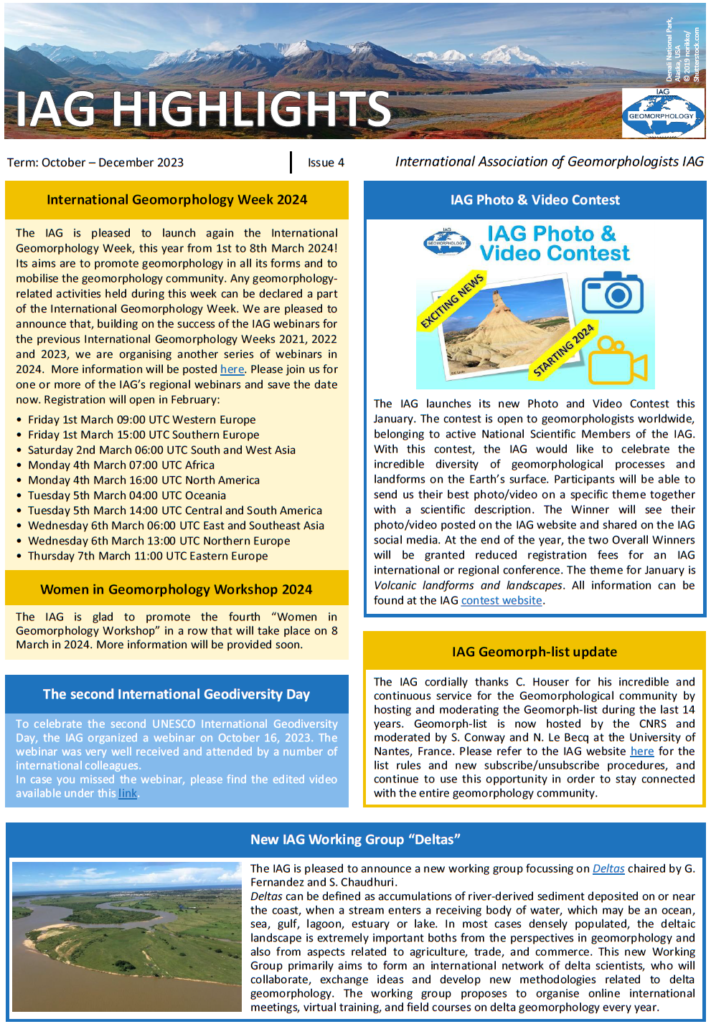


The IAG is happy to release the 3rd issue of its Highlights for 2023, focusing on the period July-September. Find this document in PDF here.
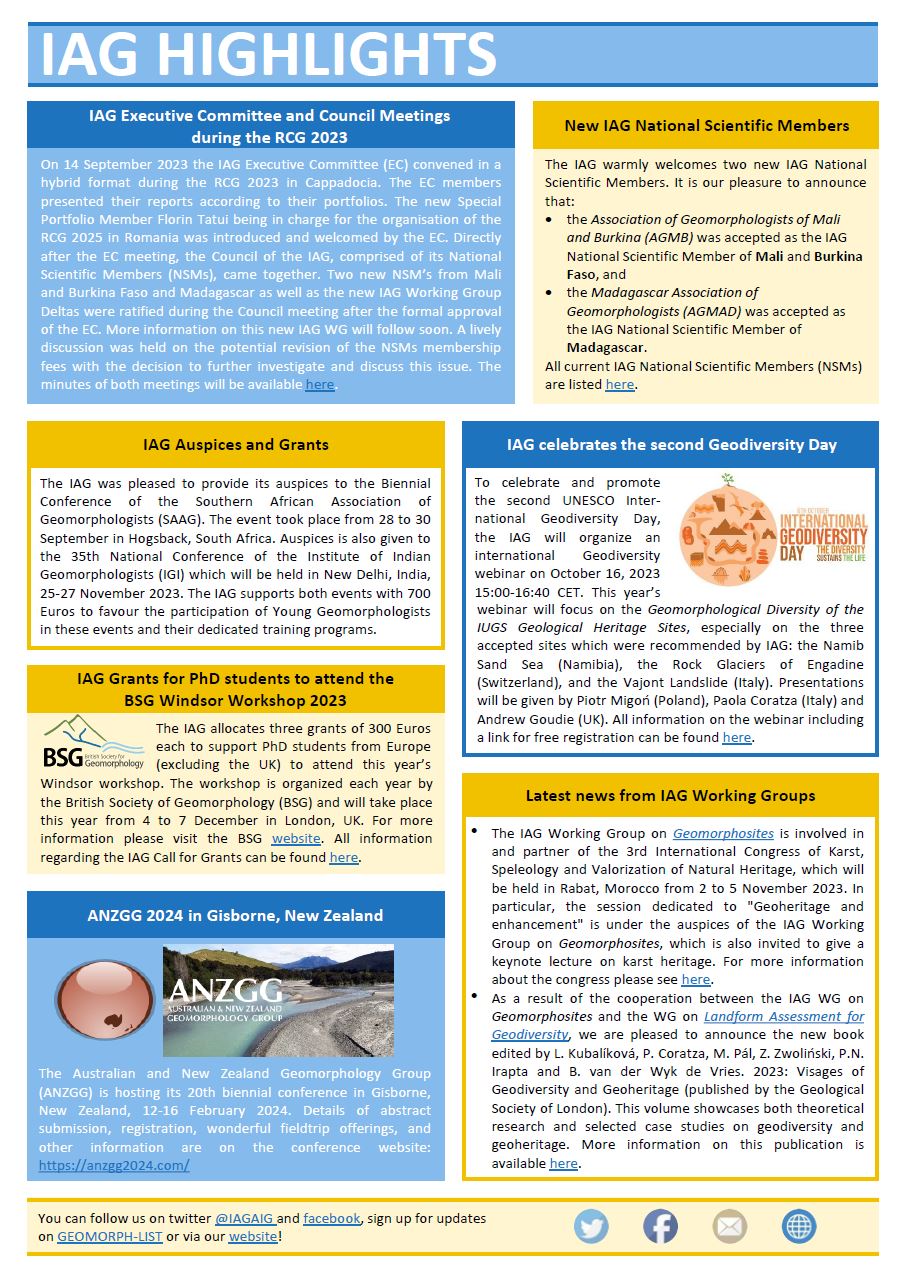

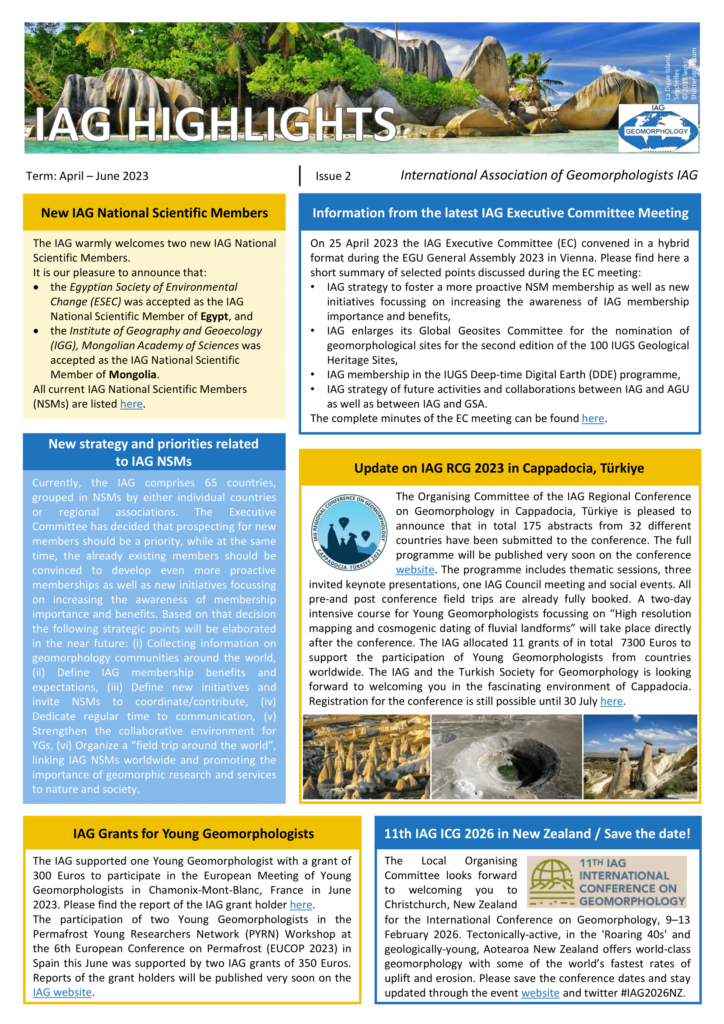 The IAG is happy to release the 2nd issue of its Highlights for 2023, focusing on the period April-June. Find this document in PDF here.
The IAG is happy to release the 2nd issue of its Highlights for 2023, focusing on the period April-June. Find this document in PDF here.


 The IAG is happy to release the 1st issue of its Highlights for 2023, focusing on the period January-March. Find this document in PDF here.
The IAG is happy to release the 1st issue of its Highlights for 2023, focusing on the period January-March. Find this document in PDF here.
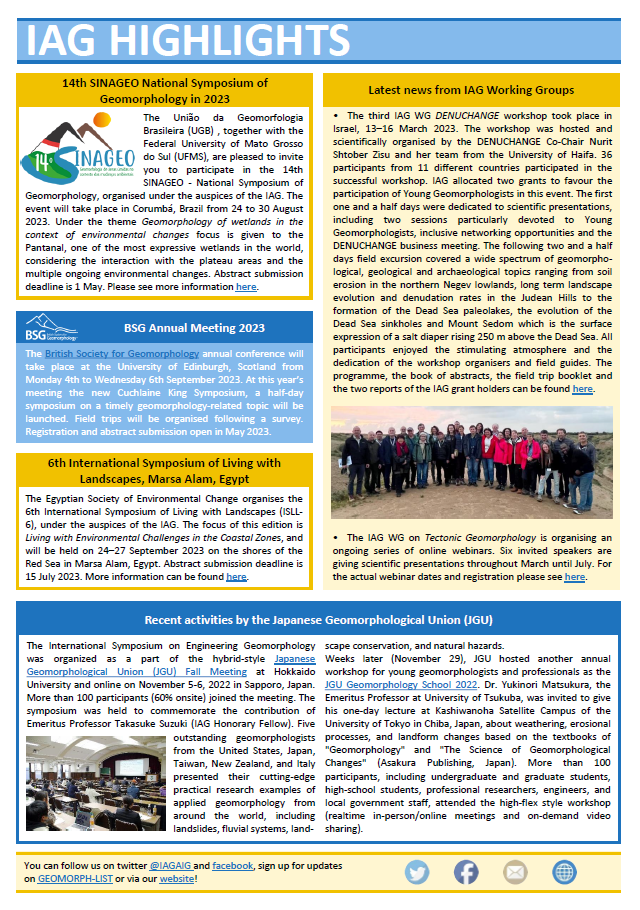

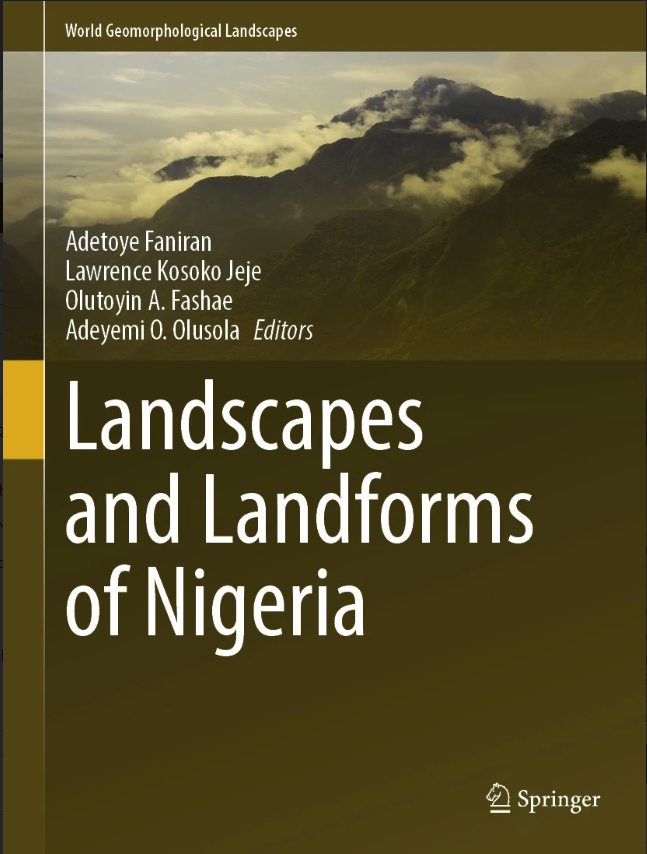 The IAG-endorsed Springer book series on “World Geomorphological Landscapes” welcomes its 28th volume! It contains 19 chapters on the “Landscapes and Landforms of Nigeria“. Find details and purchase options here.
The IAG-endorsed Springer book series on “World Geomorphological Landscapes” welcomes its 28th volume! It contains 19 chapters on the “Landscapes and Landforms of Nigeria“. Find details and purchase options here.


The 10th International Conference on Geomorphology (Coimbra, Portugal), that was held in September 2022, has resulted in the preparation of 10 Special Issues coming from various scientific Sessions:


The IAG-endorsed Springer book series on “World Geomorphological Landscapes” welcomes its 27th volume! It contains 14 chapters on the “Landscapes and Landforms of the Horn of Africa. Eritrea, Djibouti, Somalia“. Find details and purchase options here.


The Badlands Working Group from the IAG organises a Special Issue in the Mediterranean Geosciences Reviews, entitled “The Origin, Dynamics, and Diversity of Badlands in the Mediterranean and other terrestrial environments“. This Special Issue aims at being interdisciplinary, including the origin of badlands landscapes, erosion dynamics and rate, effects of climate, or badlands landscape evolution modelling – among others. Find the flyer in .pdf here.
You can submit your paper before 12 June 2023, using Springer Nature MEGR’s online submission platform. Find the guideline for authors here, and more information about the journal here. Note that the publication is planned for March 2024.


The IAG congratulates Profs. Jo De Waele (University of Bologna, Italy) and Francisco Gutiérrez (University of Zaragoza, Spain) for the recent publication of “Karst Hydrogeology, Geomorphology and Caves” with Wiley! This book provides a comprehensive review of many aspects of karst science. Purchase this book with a 20% discount until December 31st – details on the flyer here.


The IAG is happy to announce the publication of “Landscapes and Landforms of Botswana“, the 25th book of the IAG-endorsed Springer book series on “World Geomorphological Landscapes”! Find details and purchase options by clicking here.

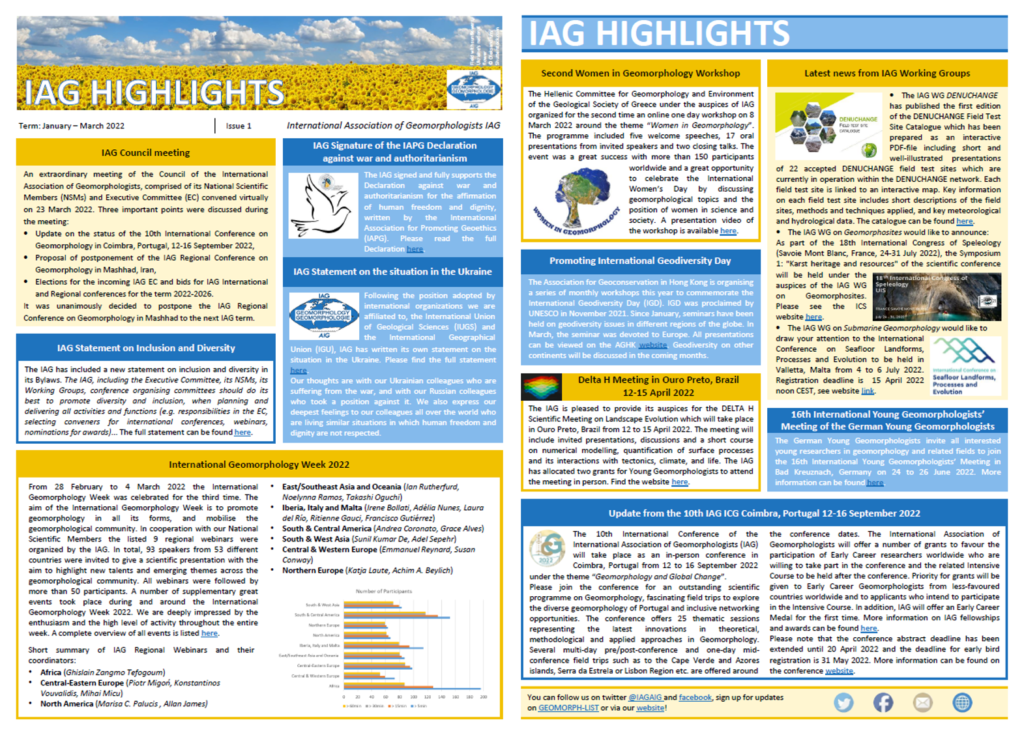
The IAG is glad to share the 1st issue of its 2022 Highlights, focusing on news, events and activities of the first quarter of 2022! Find this document in .pdf here.

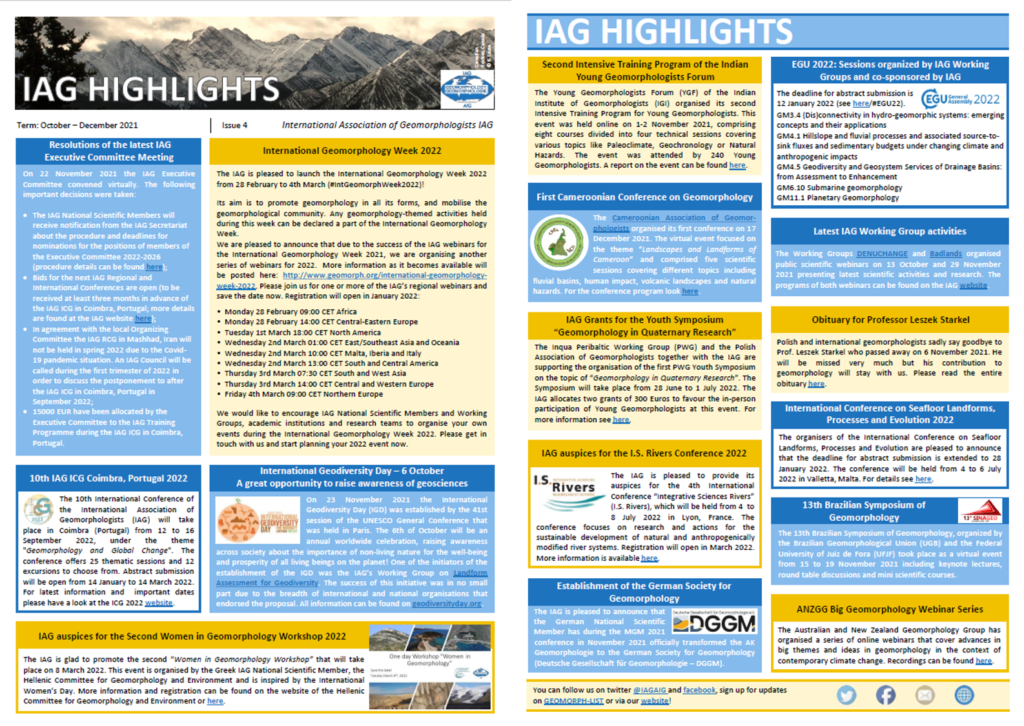
The IAG is pleased to share the 4th (and last) issue of its 2021 Highlights, focusing on news, events and activities of the fourth quarter of 2021! Find this document in .pdf here.

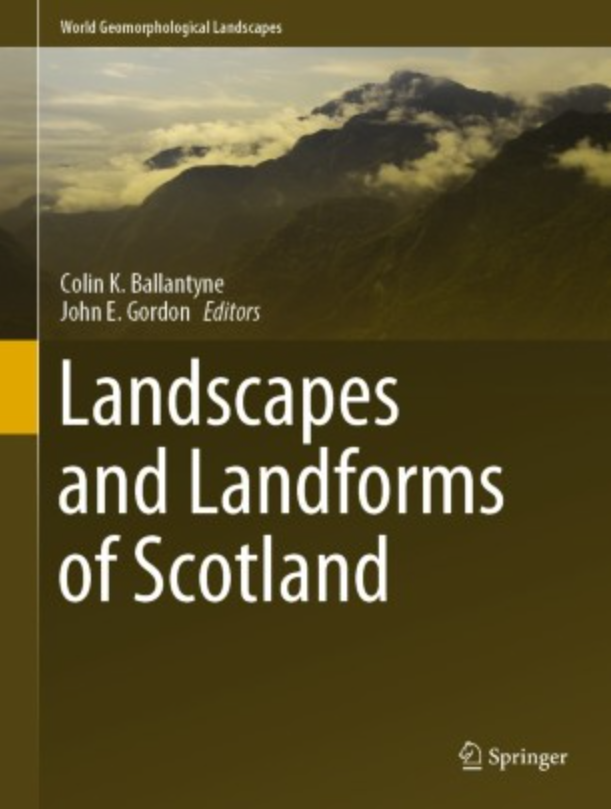
The IAG is glad to announce the publication of “Landscapes and Landforms of Scotland” – a new book of the IAG-endorsed Springer book series on “World Geomorphological Landscapes”! You can purchase it on the Springer website following this link: https://www.springer.com/gp/book/9783030712457.

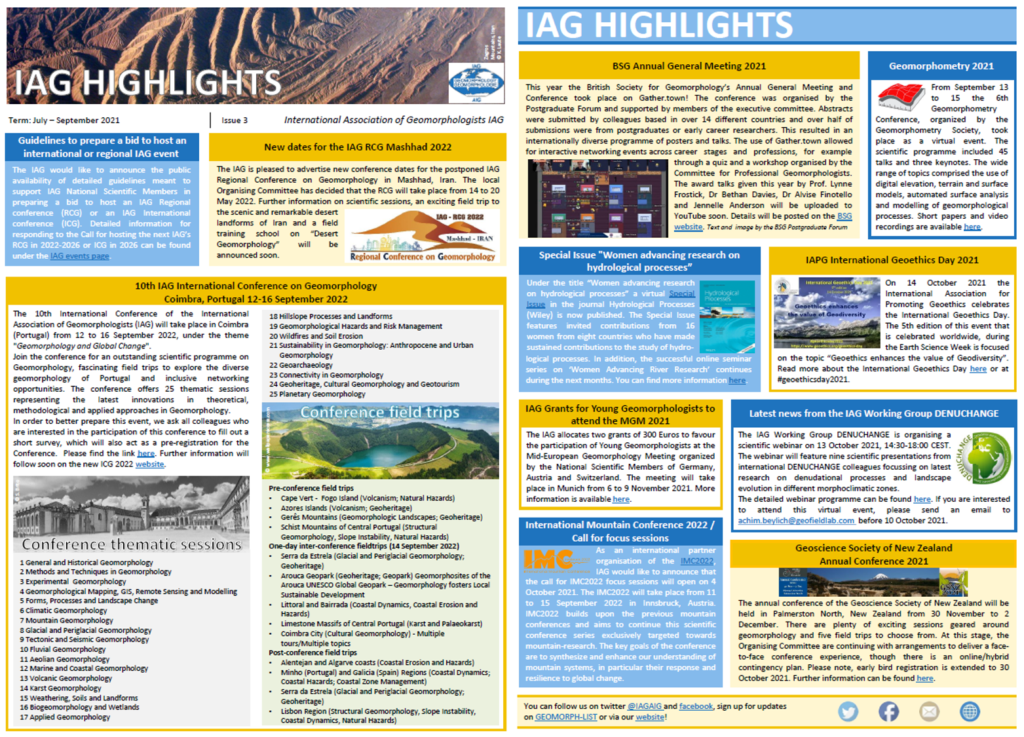
The IAG is happy to announce the publication of the third issue of the 2021 IAG Highlights, focusing on its events and activities of the third quarter of 2021! See a copy in PDF here.

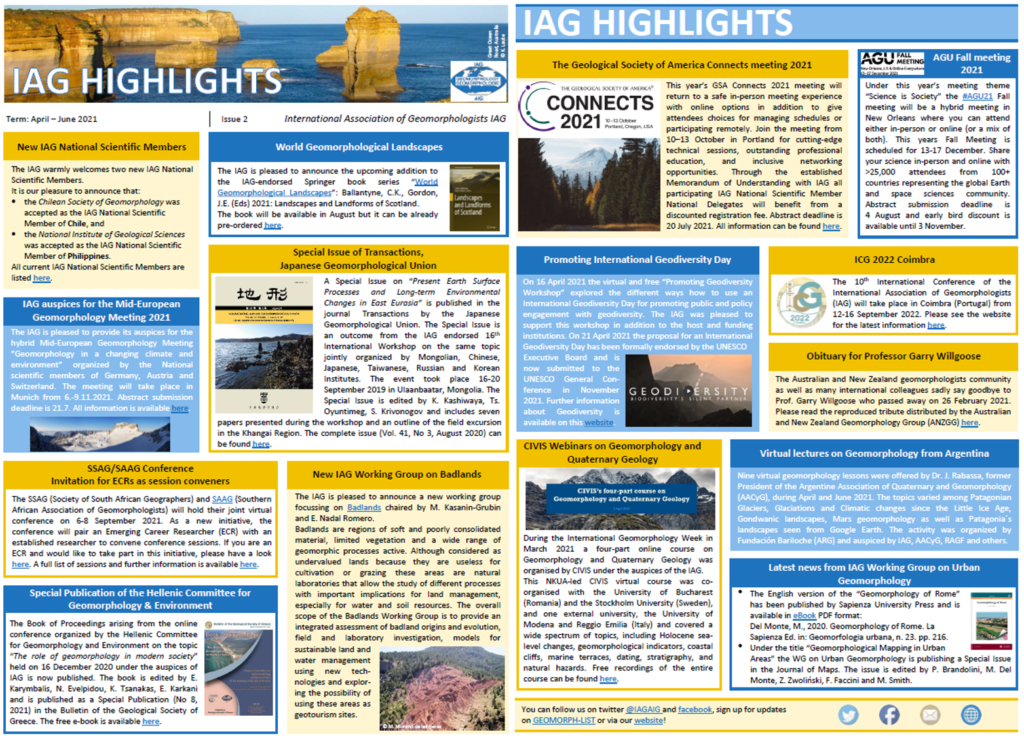
The IAG is glad to publish the second issue of the 2021 IAG Highlights, focusing on its events and activities of the second quarter of 2021! See a copy in PDF here.

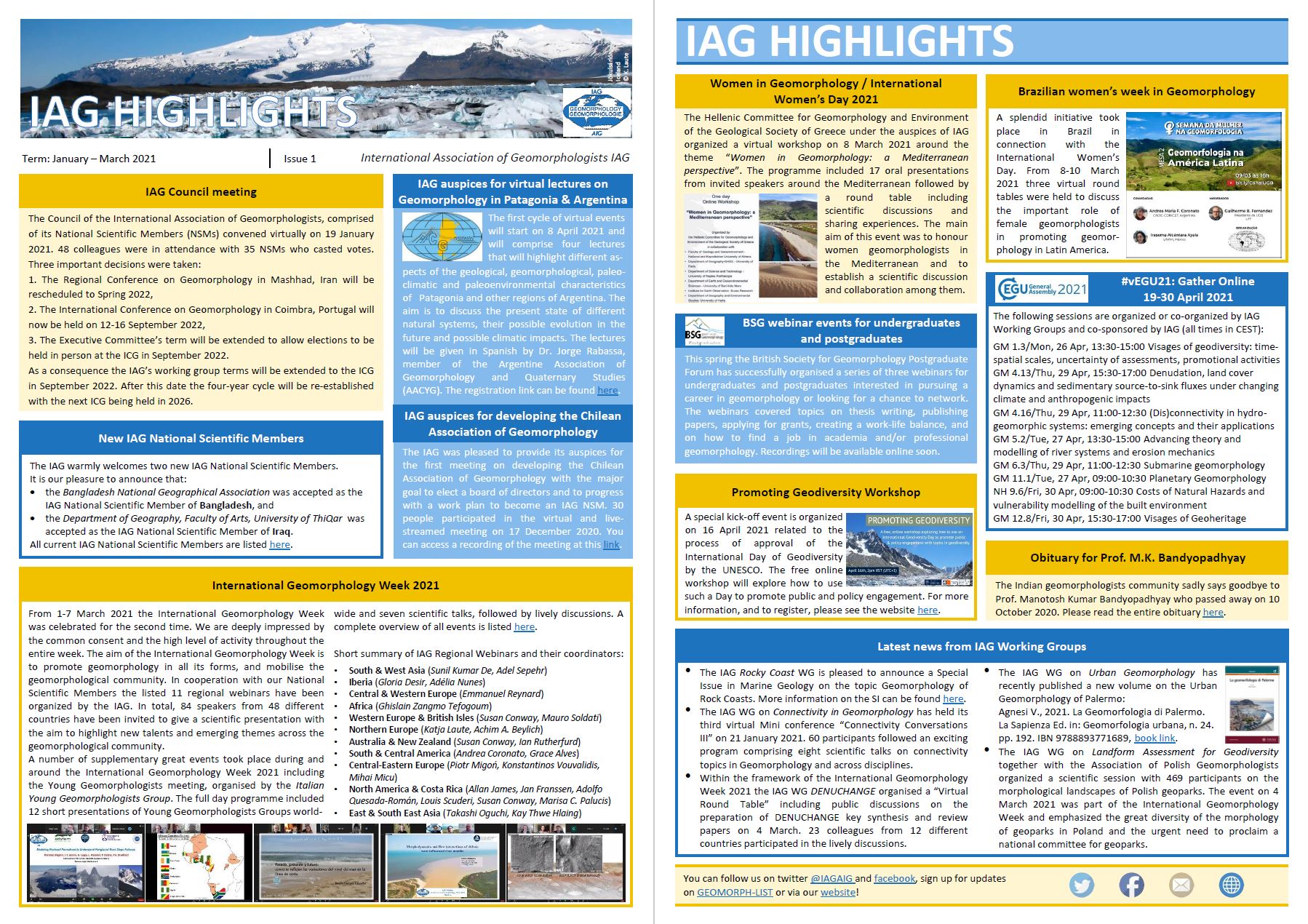 We are happy to publish the first issue of the 2021 IAG Highlights, which summarises the various activities of the IAG in the first quarter of 2021 and upcoming news. You can find a PDF copy here!
We are happy to publish the first issue of the 2021 IAG Highlights, which summarises the various activities of the IAG in the first quarter of 2021 and upcoming news. You can find a PDF copy here!

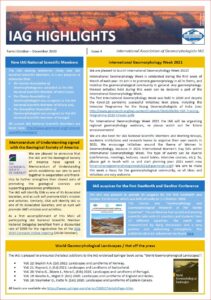 We’re pleased to circulate the latest IAG highlights revamped and compiled by the newly appointed special portfolio memberof the IAG executive committee Katja Laute! Find out what has been going on in the working groups, amongst our national members and young geomorphologists! You can download the PDF here.
We’re pleased to circulate the latest IAG highlights revamped and compiled by the newly appointed special portfolio memberof the IAG executive committee Katja Laute! Find out what has been going on in the working groups, amongst our national members and young geomorphologists! You can download the PDF here.

 Hot on the heels of Landscapes and Landforms of England and Wales we are pleased to announce that Landscapes and Landforms of Portugal edited jointly by is now available via: https://link.springer.com/book/10.1007/978-3-319-03641-0. This will be a great introduction to those of you planning to attend the IAG’s 10th International Conference on Geomorphology in Coimbra Portugal next year (6-10 September 2021)!
Hot on the heels of Landscapes and Landforms of England and Wales we are pleased to announce that Landscapes and Landforms of Portugal edited jointly by is now available via: https://link.springer.com/book/10.1007/978-3-319-03641-0. This will be a great introduction to those of you planning to attend the IAG’s 10th International Conference on Geomorphology in Coimbra Portugal next year (6-10 September 2021)!

 The latest addition to the IAG-endorsed series “World Geomorphological Landscapes” is now out! “Landscapes and Landforms of England and Wales”, edited jointly by Andrew Goudie and Piotr Migoń, is available via https://www.springer.com/gp/book/9783030389567 It is more than 600 pages long and contains overviews of long-term landform evolution, rock-relief relationships, Quaternary and the human impact, followed by 27 regional studies covering characteristic geomorphological landscapes, from coasts and flatlands to formerly glaciated mountains. The volume is dedicated to the first President of the IAG, Professor Denys Brunsden, with a special foreword from Mauro Soldati, the current IAG President. This volume is no. 19 in the successful series launched at the occasion of the International Conference on Geomorphology in Paris in 2013.
The latest addition to the IAG-endorsed series “World Geomorphological Landscapes” is now out! “Landscapes and Landforms of England and Wales”, edited jointly by Andrew Goudie and Piotr Migoń, is available via https://www.springer.com/gp/book/9783030389567 It is more than 600 pages long and contains overviews of long-term landform evolution, rock-relief relationships, Quaternary and the human impact, followed by 27 regional studies covering characteristic geomorphological landscapes, from coasts and flatlands to formerly glaciated mountains. The volume is dedicated to the first President of the IAG, Professor Denys Brunsden, with a special foreword from Mauro Soldati, the current IAG President. This volume is no. 19 in the successful series launched at the occasion of the International Conference on Geomorphology in Paris in 2013.

We’re pleased to publish the IAG Highlights from January-February 2019, which you can find here. The IAG highlights replaces the traditional newsletter.

We’re pleased to publish the IAG Highlights from July-December 2018, which you can find here. The IAG highlights replaces the traditional newsletter.

A summary of the activities in 2017-2018 of the National Member of the IAG “The Belgian Association of Geomorphologists” can be found here.
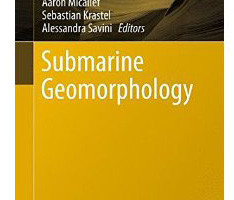
The final version of the edited book Submarine Geomorphology, is now available online and in print from Springer.
The Editors Aaron Micallef, Sebastian Krastel and Alessandra Savini would like to thank all the authors who have contributed to this book.
The book will be officially launched at the 9th International Conference on Geomorphology, taking place in New Delhi in November.
This book on the current state of knowledge of submarine geomorphology aims to achieve the goals of the Submarine Geomorphology working group, set up in 2013, by establishing submarine geomorphology as a field of research, disseminating its concepts and techniques among earth scientists and professionals, and encouraging students to develop their skills and knowledge in this field.
Editors have invited 30 experts from around the world to contribute chapters to this book, which is divided into 4 sections – (i) Introduction & history, (ii) Data & methods, (ii) Submarine landforms & processes and (iv) Conclusions & future directions. Each chapter provides a review of a topic, establishes the state-of-the-art, identifies the key research questions that need to be addressed, and delineates a strategy on how to achieve this.
Submarine geomorphology is a priority for many research institutions, government authorities and industries globally. The book is useful for undergraduate and graduate students, and professionals with limited training in this field.

The International Association of Geomorphologists held its 2015 Regional Conference at Barnaul in southern Siberia. A number of participants determined to share their common interest in geohazards by collecting a coherent set of papers around the theme of “geomorphological hazards: past and present”.
EDITORIAL
| Geomorphological Hazards: Past and Present – Introduction to the Special Issue
Olav Slaymaker, Andrei Panin, Mihai Micu, Sunil Kumar De pp. 90-91 |
PDF
|
STATE-OF-THE-ART REVIEWS
| A Review of Three Significant Geohazards in the Canadian Cordillera: the Case of River Floods, Debris Flows/Floods, and Debris/Rock Avalanches
Olav Slaymaker pp. 92-103 |
|
ARTICLES
| Quantitative Estimations of the Holocene Erosion due to Seismically Induced Landslides in the SE Altai (Russia)Applying Detailed Profiling and Statistical Approaches
Roman Nepop, Anna Agatova pp. 104-118 |
|
| Geophysical Investigation and Management Plan of a Shallow Landslide along the NH-44 in Atharamura Hill, Tripura, India
Kapil Ghosh, Shreya Bandyopadhyay, Sunil Kumar De pp. 119-130 |
|
TECHNICAL NOTES
| The Role of Catastrophic Floods Generated by Collapse of Natural Dams Since the Neolithic in the Oases of Bukhara and Qaraqöl: Preliminary Results
Eric Fouache, Rocco Rante, Djamal Mirzaakhmedov, Rachid Ragala, Malvina Dupays, Claude Vella, Jules Fleury, Valerie Andrieu-Ponnel, Antoine Zink, Elisa Porto, Frédérique Brunet, Lucie Cez pp. 150-165 |
|
| Debris Flows of the Tunkinsky Goltsy Mountains (Tunkinsky District, Republic of Buryatia in Eastern Siberia)
Stanislav Makarov, Anna Cherkashina, Zhanna Atutova, Aleksandr Bardash, Nadezhda Voropai, Natalija Kichigina, Boris Mutin, Olga Osipova, Natalija Ukhova pp. 166-179 |
|
| Modern and Late Holocene Flash Floods in the Silesian Upland (Southern Poland) Detected from Transformation of Periglacial Valleys: Case Study near Kromołów
Tomasz Kalicki, Artur Zieliński, Paweł Przepióra, Sławomir Chwałek, Marcin Frączek, Edyta Kłusakiewicz, Ireneusz Olszak, Łukasz Podrzycki pp. 180-189 |
|

Human Interference on River Health
A Study on the Haora River, Tripura, India
Authors: Bandyopadhyay, Shreya; De, Sunil Kumar
Springer
This book examines in detail the health of India’s Haora River, which is of vital importance as the lifeline of Agartala, the Capital City of Tripura. From its source in the Baramura Hills, the river debouches onto the rolling plains of Chandrasadhubari. Thousands of people between Chandrasadhubari and the boundary of Bangladesh have settled along the riverbanks and are directly dependent on the river.
Since the 1970s the ever-growing population of the Haora River basin has been exerting tremendous pressure on the river. Several anthropogenic activities affect the river, increasing sedimentation and pollution, and are leading the Haora River toward its dying phase.
This book presents the problems related to the overall health of the Haora River and discusses some proposals for restoring the ecological balance and geo-political stability of this strategically important part of the country.
Highlights of the book:
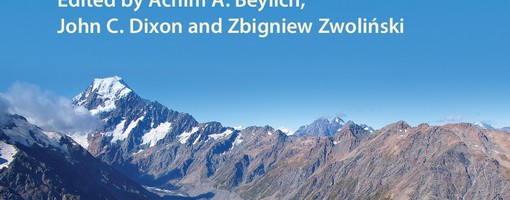
The SEDIBUD Working Group Synthesis Book is now published!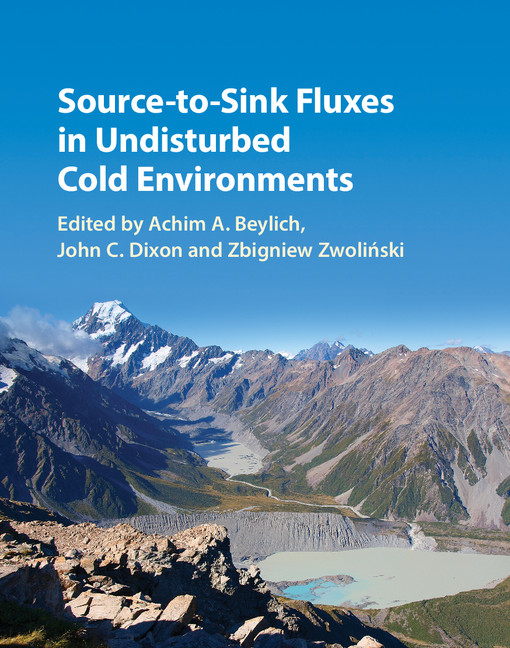
Amplified climate change and ecological sensitivity of polar and cold climate environments are key global environment issues. Understanding how projected climate change will alter surface environments in these regions is only possible when present day source-to-sink fluxes can be quantified. The book provides the first global synthesis and integrated analysis of environmental drivers and quantitative rates of solute and sedimentary fluxes in cold environments, and the likely impact of projected climate change. The focus on largely undisturbed cold environments allows ongoing climate change effects to be detected and, moreover, distinguished from anthropogenic impacts. A novel approach for co-ordinated and integrative process geomorphic research is introduced to enable better comparison between studies. This highly topical and multidisciplinary book, which includes case studies covering Arctic, Antarctic, and alpine environments, will be of interest to graduate students and researchers in the fields of geomorphology, sedimentology and global environmental change.
For further information: http://www.cambridge.org/9781107068223
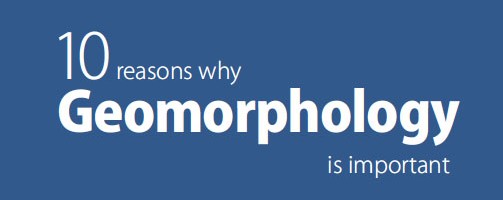
“In today’s world, there is much interest in, and concern about, the global environment and how it operates and changes. The threats of climate change and species extinctions are commonly highlighted, but what about the potential changes to physical landscapes? Understanding how landscapes operate and change is a crucial part of gaining a full understanding of the Earth system and enabling better environmental management. There are many questions that remain to be answered about physical landscapes and our interactions with them.”
Stephen Tooth and Heather Viles, with input from the British Society for Geomorphology (BSG) Executive Committee, prepared this document to explain the fundamental role of Geomorphology for Science and Society!